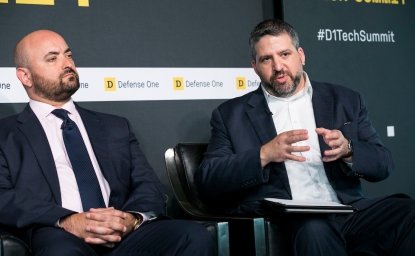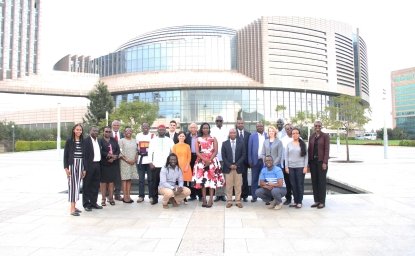
A blog of the Wilson Center
Elizabeth Newbury is the Director and Program Associate for the Serious Games Initiative (SGI) for the Wilson Center, leading Wilson's use of games in engaging the public around policy research. As lead of the Serious Games Initiative, she leverages games as a tool for the public communication of science and policy research. Current projects include the Fiscal Ship, a game about the federal budget developed and maintained in collaboration with the Hutchins Center on Fiscal and Monetary Policy with the Brookings Institution. Collaborating across the Wilson Center, her current projects include games pertaining to cybsercurity, to the history of nuclear proliferation, and to polar issues. Under her leadership, SGI is pursuing how public policy and science can come together in an interactive platform to increase public dialogue and engagement around critical issues of today.
Known as the "Sundance of Video Games," Games for Change is a festival that aims to show that real social change can be enacted by way of "serious games"--games whose purpose is greater than entertainment. Now in its 15th year, Games for Change 2018 ran from June 25 to June 30 in New York City with over 1000 attendees.
What do you hope that people took away from Games for Change?
Games for Change (G4C) has a specific focus: to demonstrate that games can have positive social impact. Games are often given a bad reputation as frivolous, or a waste of time. Something purely for entertainment. But there’s a growing number of people who can demonstrate that games can be used for high-impact in education, civic engagement, and to better research. These are often called “serious games” – games that go beyond pure entertainment. That games can foster connection, that games can be used to solve problems that we’re facing, whether that’s teaching history or improving mental health. Games for Change highlights those efforts, bringing these heroes to the forefront and giving them a stage to show the world that games are a tool for good. So I hope what people took away from attending Games for Change was how they can bring lessons learned in using games for this purpose and think about how they can use games to address real world problems, no matter the spectrum of that problem.
Can you think of any powerful moment from this year’s Games for Change?
The keynote speakers are always wonderful at Games for Change, because they walk through big ideas that are shaping not only how we can address real world issues, but also changing the shape of the game industry itself. But for me, some of the most impactful moments are the ability to connect with multiple stakeholders in one space and have open dialogue about the latest and greatest in gaming pedagogy. From educators to educational tech developers, to other government agencies to nonprofits, academics to industry leaders, Games for Change is a festival that unites people who are eager and willing to think outside of the box and make real-world changes through one of the most dynamic platforms we have available to us today: games.
What were some of the games you enjoyed playing?
Part of my profession is to understand what is the latest and greatest in games, and for serious games, the Games for Change Festival is incredibly useful. They set up a large arcade of games, where participants can go and try out some of the newest titles. The games ran the spectrum of themes, from ethical implications of AI to exploring World War II history to giving young cancer patients an understanding of their medical treatment. I didn’t play as many of the games this year, but two that I did get to play were on opposite ends of the tech spectrum. One was called Tree, where you are put in an immersive virtual reality experience and get to live life as a tree. It won the award for Most Innovative game this year. The second was Bury me, My Love, which was an SMS styled game following a fictional narrative of Syrian migrants trying to find their way to Europe. Both demonstrated the power of narrative as being key to the learning experience.
What was your role throughout the festival, particularly as co-chair for the Federal Games Guild?
One hat I was wearing at G4C was my FGG membership hat. I help organize an informal community of practice called the Federal Games Guild (FGG) that brings together staff of federal entities who have a common interest in employing games as part of meeting their core objectives. Federal entities—like the Wilson Center—are involved in serious games through a variety of ways, from researching the applications of games to using games to meet core objectives to outreach and education to funding interactive digital media. I believe it is important to support the ecosystem of serious games, in no small part because the Wilson Center has an extensive history of being a leader in this space with my predecessors. So I help organize meetups at venues like G4C for FGG, and try to make ourselves as visible as possible.
Another hat I was wearing at the festival was a researcher. I was fortunate to be asked onto a panel by Steve Isaacs that addressed the K12 pipeline for esports. Esports is where games are played in a competitive environment, like a sport, but can be about any game title—so not just Madden, but also Rocket League, Overwatch, and so on. It’s a booming international industry, with Business Insider reporting that esports will be a $1.5 billion industry by 2020. It’s also where I cut my teeth in research, so I was grateful to be included on a panel discussing how we should think about how esports intersects with existing educational practices.
Author


Serious Games Initiative
The Serious Games Initiative communicates science and policy complexities through the world’s most dynamic medium: gaming. Read more


Science and Technology Innovation Program
The Science and Technology Innovation Program (STIP) serves as the bridge between technologists, policymakers, industry, and global stakeholders. Read more

Explore More in Wilson on the Road
Browse Wilson on the Road
Defense One Tech Summit 2019


